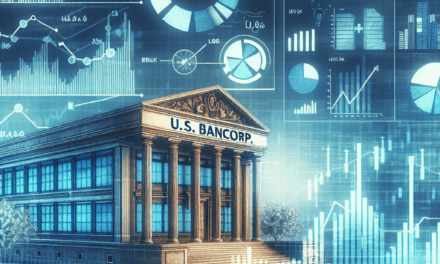“Election Day: The Turning Point for Wall Street’s Future”
Introduction
Election Day often serves as a critical juncture for Wall Street, with potential shifts in political power and policy direction influencing market dynamics. As investors brace for the outcomes, the anticipation of regulatory changes, fiscal policies, and economic strategies can lead to significant market volatility. The prospect of new leadership or the continuation of existing governance can impact sectors differently, prompting strategic adjustments in portfolios. This pivotal moment underscores the intricate relationship between politics and financial markets, highlighting the importance of understanding electoral implications for future investment landscapes.
Impact Of Election Day On Stock Market Volatility
As Election Day approaches, investors and financial analysts alike are keenly observing the potential implications for Wall Street, anticipating that the outcome could herald a significant shift in stock market dynamics. Historically, elections have been pivotal events that introduce a degree of uncertainty, often leading to increased market volatility. This year is no exception, as the stakes are particularly high given the current economic climate and the diverse policy proposals from the candidates. Consequently, understanding the potential impact of Election Day on stock market volatility is crucial for investors seeking to navigate these turbulent waters.
To begin with, it is essential to recognize that the stock market is inherently sensitive to political developments. Elections, by their very nature, introduce uncertainty regarding future economic policies, regulatory changes, and fiscal strategies. This uncertainty can lead to heightened volatility as investors attempt to predict and react to potential shifts in the economic landscape. For instance, changes in tax policies, government spending, and trade agreements can have profound effects on corporate earnings and, by extension, stock prices. As a result, the period leading up to and immediately following an election often sees increased market fluctuations as investors adjust their portfolios in response to anticipated policy changes.
Moreover, the current economic environment adds an additional layer of complexity to this year’s election. With inflationary pressures, interest rate hikes, and global supply chain disruptions already contributing to market instability, the election outcome could either exacerbate or alleviate these challenges. For example, a candidate proposing aggressive fiscal stimulus might be perceived as beneficial for economic growth in the short term, potentially boosting stock prices. Conversely, a focus on austerity measures could be seen as a drag on economic recovery, leading to a more cautious market response. Thus, the election results could serve as a catalyst for either increased optimism or heightened caution among investors.
In addition to domestic policy considerations, the global context cannot be overlooked. The interconnectedness of global markets means that U.S. elections can have far-reaching implications beyond national borders. International investors closely monitor U.S. elections, as changes in American foreign policy, trade relations, and geopolitical strategies can significantly impact global markets. Consequently, the election outcome could influence not only domestic stock market volatility but also international market dynamics, further complicating the investment landscape.
Furthermore, it is important to consider the role of investor sentiment in driving market volatility around elections. Elections often evoke strong emotions and opinions, which can lead to irrational market behavior. Fear and uncertainty may prompt some investors to sell off assets, while others may see opportunities for strategic investments. This divergence in investor behavior can contribute to increased market volatility as differing perspectives clash in the marketplace. Therefore, understanding the psychological factors at play is essential for anticipating potential market movements.
In conclusion, Election Day represents a critical juncture for Wall Street, with the potential to significantly influence stock market volatility. The interplay of political uncertainty, economic conditions, global considerations, and investor sentiment creates a complex environment that requires careful navigation. As investors brace for the election’s outcome, they must remain vigilant and adaptable, ready to respond to the evolving landscape. By staying informed and considering the multifaceted factors at play, investors can better position themselves to manage the risks and opportunities that Election Day may present.
Historical Trends: How Elections Influence Wall Street
As Election Day approaches, investors and analysts alike are keenly observing the potential implications for Wall Street, a practice rooted in historical trends that have long demonstrated the influence of political outcomes on financial markets. Historically, the stock market has shown a tendency to react to the political climate, with varying degrees of volatility and optimism depending on the election results. This phenomenon is not merely a modern occurrence; rather, it has been a consistent pattern throughout the history of the United States, reflecting the intricate relationship between politics and economics.
To understand how elections influence Wall Street, it is essential to consider the market’s behavior in the months leading up to and following an election. Typically, the period preceding an election is characterized by uncertainty, as investors grapple with the potential policy changes that could arise from a shift in political power. This uncertainty often leads to increased market volatility, as traders attempt to anticipate the economic implications of different electoral outcomes. For instance, the prospect of a new administration may bring with it changes in fiscal policy, regulatory adjustments, and shifts in international trade agreements, all of which can significantly impact market dynamics.
Moreover, historical data suggests that the stock market tends to perform differently under Democratic and Republican administrations, although the reasons for these differences are complex and multifaceted. Generally, markets have shown a preference for stability and predictability, which can be influenced by the perceived economic policies of the incoming administration. For example, Republican administrations are often associated with tax cuts and deregulation, policies that are typically viewed favorably by investors. Conversely, Democratic administrations may focus on increased government spending and regulatory oversight, which can lead to mixed reactions from the market.
Despite these general trends, it is crucial to recognize that the stock market’s response to elections is not solely determined by the party in power. Other factors, such as the state of the economy, geopolitical tensions, and global market conditions, also play significant roles in shaping market reactions. Furthermore, the immediate aftermath of an election can be marked by a “relief rally,” where markets respond positively simply due to the resolution of uncertainty, regardless of the winning party.
In addition to these short-term effects, elections can also have long-term implications for Wall Street. The policies implemented by an administration can set the tone for economic growth, corporate profitability, and investor confidence over the course of several years. For instance, infrastructure spending initiatives or changes in healthcare policy can create new opportunities for certain sectors, while simultaneously posing challenges for others. As such, investors must remain vigilant and adaptable, continuously assessing the evolving political landscape and its potential impact on their portfolios.
In conclusion, while historical trends provide valuable insights into how elections influence Wall Street, it is important to approach these patterns with a nuanced understanding of the myriad factors at play. As Election Day draws near, market participants will undoubtedly be watching closely, aware that the outcome could mark a pivotal shift for Wall Street. By examining past trends and considering the broader economic context, investors can better navigate the complexities of the market during this critical period, positioning themselves to capitalize on the opportunities and challenges that lie ahead.
Key Sectors To Watch Post-Election Day
As Election Day approaches, investors and analysts alike are keenly observing the potential implications for Wall Street, with particular attention to key sectors that could experience significant shifts. Historically, elections have been pivotal moments for financial markets, often resulting in volatility and uncertainty. However, they also present opportunities for strategic investments, as policy changes and new legislative priorities can dramatically alter the landscape for various industries. In this context, understanding which sectors are poised for transformation is crucial for investors seeking to navigate the post-election environment effectively.
To begin with, the energy sector is likely to be at the forefront of any post-election shifts. Depending on the election outcome, policies related to renewable energy and fossil fuels could diverge significantly. A government favoring green energy initiatives might accelerate investments in solar, wind, and other renewable sources, potentially boosting companies involved in these areas. Conversely, a continuation or expansion of support for traditional energy sources could benefit oil and gas companies. Thus, investors should closely monitor policy signals that could influence energy market dynamics.
In addition to energy, the healthcare sector remains a critical area of focus. Healthcare policy is often a contentious issue during elections, with debates surrounding insurance coverage, drug pricing, and healthcare access. Changes in administration could lead to reforms that impact pharmaceutical companies, insurance providers, and healthcare service firms. For instance, policies aimed at reducing drug prices could pressure pharmaceutical profit margins, while expanded healthcare access might increase demand for services, benefiting hospitals and clinics. Therefore, stakeholders in the healthcare sector should be prepared for potential regulatory changes that could reshape the industry landscape.
Moreover, the technology sector, a perennial driver of market growth, could also experience shifts based on election outcomes. Issues such as data privacy, antitrust regulations, and digital infrastructure investment are likely to be influenced by the political climate. A government prioritizing stricter regulations on tech giants might lead to increased scrutiny and potential restructuring within the industry. On the other hand, policies promoting technological innovation and infrastructure development could spur growth and create new opportunities for tech companies. Consequently, investors should remain vigilant regarding policy developments that could impact the technology sector’s trajectory.
Furthermore, the financial sector is another area where election results could have profound implications. Regulatory changes, tax policies, and economic stimulus measures are all factors that can influence the banking and financial services industry. A government inclined towards deregulation might ease constraints on financial institutions, potentially enhancing profitability. Conversely, increased regulation could impose additional compliance costs and operational challenges. Additionally, fiscal policies affecting interest rates and inflation could impact lending practices and investment strategies within the sector. As such, financial institutions and investors should be prepared to adapt to a potentially shifting regulatory environment.
Finally, the manufacturing and industrial sectors may also be affected by post-election policy changes, particularly in areas related to trade, tariffs, and infrastructure spending. A government focused on boosting domestic manufacturing and infrastructure development could create opportunities for companies involved in construction, transportation, and related industries. Conversely, changes in trade policies could impact supply chains and international competitiveness. Therefore, businesses and investors in these sectors should be attuned to policy directions that could influence their operations and market conditions.
In conclusion, Election Day holds the potential to mark a pivotal shift for Wall Street, with key sectors such as energy, healthcare, technology, finance, and manufacturing poised for transformation. By closely monitoring policy developments and understanding their implications, investors can position themselves strategically to capitalize on the opportunities and navigate the challenges that may arise in the post-election landscape.
Investor Sentiment: Pre And Post-Election Analysis

As Election Day approaches, investors are keenly observing the potential implications for Wall Street, with many anticipating that the outcome could herald a significant shift in market dynamics. Historically, elections have been pivotal moments for financial markets, often leading to fluctuations in investor sentiment and market performance. This year is no exception, as the political landscape presents a myriad of possibilities that could influence economic policies and, consequently, market behavior.
In the months leading up to the election, investor sentiment has been characterized by a mix of caution and optimism. On one hand, the uncertainty surrounding the election results has led some investors to adopt a more conservative approach, opting to minimize risk by reallocating assets into safer investments such as bonds or gold. This cautious stance is driven by concerns over potential policy changes that could impact sectors like healthcare, energy, and technology. On the other hand, there is a sense of optimism among investors who believe that the election could bring about favorable policy shifts, such as tax reforms or increased government spending, which could stimulate economic growth and boost corporate earnings.
As the election draws nearer, market analysts have been closely monitoring key indicators of investor sentiment, such as the volatility index (VIX) and trading volumes. These metrics provide valuable insights into how investors are positioning themselves in anticipation of the election outcome. A noticeable increase in the VIX, for instance, suggests heightened uncertainty and a potential for increased market volatility. Meanwhile, fluctuations in trading volumes can indicate shifts in investor confidence, as market participants adjust their portfolios in response to evolving political developments.
Post-election, the market’s reaction will largely depend on the clarity and decisiveness of the election results. A clear and uncontested outcome is likely to be welcomed by investors, as it reduces uncertainty and provides a more predictable environment for making investment decisions. In such a scenario, sectors that are expected to benefit from the winning party’s policies may experience a surge in investor interest, leading to potential gains in stock prices. Conversely, a contested or inconclusive election result could exacerbate market volatility, as investors grapple with prolonged uncertainty and the potential for policy gridlock.
Furthermore, the post-election period will be crucial in determining the long-term impact on Wall Street. Investors will be closely watching the new administration’s policy priorities and their implications for economic growth and corporate profitability. Key areas of focus will include fiscal policy, regulatory changes, and international trade relations, all of which have the potential to significantly influence market sentiment and performance.
In conclusion, Election Day represents a critical juncture for Wall Street, with the potential to reshape investor sentiment and market dynamics. While the pre-election period has been marked by a mix of caution and optimism, the post-election landscape will be defined by the clarity of the results and the subsequent policy direction. As investors navigate this pivotal moment, they will be seeking to balance the risks and opportunities presented by the evolving political and economic environment. Ultimately, the election’s impact on Wall Street will hinge on the ability of the new administration to implement policies that foster economic stability and growth, thereby bolstering investor confidence and market performance.
Policy Changes And Their Potential Market Impact
As Election Day approaches, investors and financial analysts are keenly observing the potential policy changes that could significantly impact Wall Street. The outcome of the election is poised to influence a range of economic policies, from taxation to regulation, which in turn could lead to substantial shifts in market dynamics. Understanding these potential changes is crucial for stakeholders aiming to navigate the financial landscape effectively.
To begin with, tax policy is often at the forefront of economic discussions during election cycles. Candidates typically propose varying tax strategies that can have profound implications for both corporations and individual investors. A shift towards higher corporate taxes, for instance, could lead to reduced profit margins for companies, potentially affecting stock valuations. Conversely, a more lenient tax regime might encourage business expansion and investment, thereby boosting market confidence. Investors must therefore remain vigilant, as the election results could dictate the fiscal environment for years to come.
In addition to tax policies, regulatory changes are another critical area of focus. Different administrations have historically taken divergent approaches to regulation, particularly in sectors such as finance, healthcare, and energy. A government favoring deregulation might stimulate growth by reducing compliance costs and encouraging innovation. However, it could also raise concerns about oversight and risk management. On the other hand, a more stringent regulatory framework could enhance stability and consumer protection but might also stifle entrepreneurial ventures. Thus, the regulatory stance of the incoming administration will likely play a pivotal role in shaping market sentiment.
Moreover, trade policies are expected to be a significant determinant of market behavior post-election. Global trade dynamics have a direct impact on corporate earnings, especially for multinational companies. A protectionist trade policy could lead to increased tariffs and trade barriers, potentially disrupting supply chains and increasing costs for businesses. In contrast, policies promoting free trade might enhance market access and competitiveness, benefiting companies with international operations. Consequently, investors will be closely monitoring the election outcomes to assess potential shifts in trade relations and their implications for global markets.
Furthermore, monetary policy, while primarily the domain of central banks, can also be influenced by the political landscape. The election could affect the appointment of key figures in monetary institutions, thereby impacting interest rate policies and inflation targets. A government inclined towards expansionary fiscal policies might lead to increased borrowing and spending, influencing central bank decisions on interest rates. This interplay between fiscal and monetary policy is crucial for investors, as it affects borrowing costs, consumer spending, and overall economic growth.
In conclusion, the upcoming election holds the potential to usher in significant policy changes that could reshape Wall Street’s landscape. Taxation, regulation, trade, and monetary policy are all areas where shifts could occur, each carrying its own set of implications for the market. Investors and financial analysts must therefore remain astute, considering both the immediate and long-term effects of these potential changes. As Election Day draws near, the anticipation of these policy shifts underscores the importance of strategic planning and adaptability in navigating the ever-evolving financial environment.
Election Outcomes: Winners And Losers On Wall Street
As Election Day approaches, Wall Street is bracing for what could be a pivotal shift in the financial landscape. The outcomes of elections have historically had significant implications for the stock market, influencing investor sentiment and shaping economic policies that can either bolster or hinder market performance. This year, the stakes are particularly high, with a range of issues on the ballot that could lead to substantial changes in the regulatory and economic environment. Consequently, investors are keenly observing the political landscape, attempting to anticipate which sectors might emerge as winners or losers based on the election results.
To begin with, the financial sector is often one of the most directly impacted by election outcomes. Regulatory policies are a key concern for banks and financial institutions, as different administrations may prioritize varying levels of oversight and intervention. A government that favors deregulation could lead to a surge in financial stocks, as reduced compliance costs and increased lending flexibility can enhance profitability. Conversely, a shift towards more stringent regulations might dampen investor enthusiasm, potentially leading to a decline in stock prices within the sector.
In addition to financial institutions, the healthcare industry is another area where election results can have profound effects. Policy decisions regarding healthcare reform, drug pricing, and insurance coverage can significantly alter the landscape for pharmaceutical companies, insurers, and healthcare providers. For instance, a government that supports expanding healthcare access and controlling drug prices might pressure pharmaceutical stocks, while insurers could benefit from an increase in the insured population. On the other hand, a more market-oriented approach could favor pharmaceutical companies by allowing greater pricing flexibility, though it might pose challenges for insurers if coverage mandates are reduced.
Moreover, the energy sector stands at a crossroads, with election outcomes potentially dictating the future of fossil fuels and renewable energy. A government that prioritizes environmental sustainability and climate change initiatives could accelerate the transition towards renewable energy sources, benefiting companies involved in solar, wind, and other clean technologies. This shift could simultaneously pose challenges for traditional oil and gas companies, as stricter environmental regulations and a push for carbon neutrality might curtail their growth prospects. Conversely, an administration that supports fossil fuel development could bolster the oil and gas industry, though it might slow the momentum of renewable energy investments.
Furthermore, technology companies are closely watching the elections, as issues such as data privacy, antitrust regulations, and digital taxation are increasingly coming to the forefront. A government that seeks to impose stricter controls on tech giants could lead to increased compliance costs and potential restructuring within the industry. However, policies that promote innovation and digital infrastructure development could provide a boost to tech stocks, fostering an environment conducive to growth and expansion.
In conclusion, the upcoming elections hold the potential to reshape Wall Street’s landscape, with various sectors poised to experience differing fortunes based on the political outcomes. Investors are advised to remain vigilant, as the interplay between policy decisions and market dynamics can create both opportunities and challenges. By understanding the potential implications of election results, market participants can better position themselves to navigate the evolving financial terrain, ensuring that they are well-prepared for whatever changes may lie ahead. As Election Day draws near, the anticipation on Wall Street is palpable, with the understanding that the decisions made at the ballot box could indeed mark a pivotal shift in the financial world.
Long-Term Market Trends Following Election Day
As Election Day approaches, investors and market analysts are keenly observing the potential implications for Wall Street, anticipating that the outcome could herald a significant shift in long-term market trends. Historically, elections have been pivotal moments for financial markets, often setting the stage for new economic policies and regulatory changes that can influence market dynamics for years to come. This year, the stakes appear particularly high, with a range of economic issues at the forefront of the political discourse, including fiscal policy, taxation, and regulatory reform.
To begin with, the election results could lead to substantial changes in fiscal policy, which in turn may impact investor sentiment and market performance. A government inclined towards increased public spending could stimulate economic growth in the short term, potentially boosting sectors such as infrastructure and technology. Conversely, a focus on austerity measures might lead to a more cautious market outlook, with investors possibly reallocating resources towards more stable, defensive sectors. Thus, the fiscal direction chosen by the incoming administration will likely play a crucial role in shaping market expectations and investment strategies.
Moreover, taxation policies are another critical area where election outcomes could drive long-term market trends. Changes in corporate tax rates, for instance, can have a direct impact on company earnings and, consequently, stock valuations. A reduction in corporate taxes might lead to increased profitability for businesses, encouraging investment and potentially driving stock prices higher. On the other hand, an increase in taxes could compress profit margins, prompting companies to reassess their growth strategies and possibly leading to a more conservative market environment. Therefore, investors will be closely monitoring any proposed tax reforms, as these could significantly influence market behavior.
In addition to fiscal and taxation policies, regulatory reform is another domain where election results could have far-reaching implications for Wall Street. Different administrations often have varying approaches to regulation, with some favoring deregulation to spur economic activity, while others advocate for stricter oversight to ensure market stability and protect consumers. Changes in regulatory frameworks can affect a wide range of industries, from finance and healthcare to energy and technology. For instance, a shift towards deregulation might benefit financial institutions by reducing compliance costs and encouraging innovation, whereas increased regulation could lead to higher operational expenses and potentially stifle growth. Consequently, the regulatory stance of the new administration will be a key factor in determining the long-term trajectory of various market sectors.
Furthermore, it is essential to consider the broader geopolitical landscape, as election outcomes can influence international relations and trade policies, which are integral to global market trends. A government that prioritizes international cooperation and free trade agreements might foster a more favorable environment for multinational corporations, enhancing cross-border investments and economic growth. Conversely, a protectionist stance could lead to trade tensions and market volatility, as businesses navigate the complexities of tariffs and trade barriers. Thus, the election’s impact on foreign policy will be another critical element shaping Wall Street’s future.
In conclusion, Election Day holds the potential to mark a pivotal shift for Wall Street, with long-term market trends likely influenced by changes in fiscal policy, taxation, regulatory reform, and international relations. As investors and analysts await the election results, they remain acutely aware of the profound implications these outcomes could have on the financial landscape, underscoring the importance of strategic planning and adaptability in navigating the evolving market environment.
Q&A
1. **What is the main focus of the article “Forecast: Election Day Could Mark a Pivotal Shift for Wall Street”?**
– The article focuses on how upcoming elections could significantly impact Wall Street, potentially altering market trends and investor strategies.
2. **How might elections influence Wall Street according to the article?**
– Elections can influence Wall Street by affecting policy decisions, regulatory changes, and economic strategies that directly impact financial markets and investor confidence.
3. **What are some potential market sectors that could be affected by the election results?**
– Sectors such as healthcare, energy, and technology could be particularly affected due to differing policy priorities between political parties.
4. **Does the article suggest any specific outcomes for the stock market post-election?**
– While specific outcomes are uncertain, the article suggests that market volatility could increase as investors react to the election results and potential policy shifts.
5. **What role do investor expectations play in the context of the election and Wall Street?**
– Investor expectations play a crucial role as they anticipate changes in fiscal and monetary policies, which can lead to preemptive market movements and adjustments in investment portfolios.
6. **Are there any historical precedents mentioned that illustrate the impact of elections on Wall Street?**
– The article may reference past elections where significant policy changes led to notable shifts in market behavior, illustrating the potential impact of political outcomes on financial markets.
7. **What advice does the article offer to investors regarding the election?**
– The article likely advises investors to stay informed about political developments, consider diversifying their portfolios, and be prepared for potential market volatility surrounding the election period.
Conclusion
The conclusion about the forecast that Election Day could mark a pivotal shift for Wall Street is that the outcome of the elections has the potential to significantly influence market dynamics, investor sentiment, and regulatory landscapes. Depending on the results, there could be shifts in fiscal policies, tax regulations, and government spending priorities, all of which can impact various sectors differently. Investors may need to adjust their strategies to align with the anticipated changes in economic policies and market conditions that could arise from the election results.





